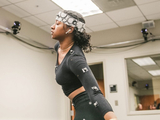This story was written by Megan Hanks and first appeared on news.umbc.edu
UMBC’s Interactive Systems Research Center (ISRC) has obtained new equipment designed for the precise study of human movement, perception, and emotion. The User Studies Lab, which includes the Motion Lab and the Perception Lab, has installed new technology through a National Science Foundation grant including a Vicon motion capture system. The Vicon system records a subject’s movement using infrared cameras and small, wearable markers affixed with tape that the cameras can track. Andrea Kleinsmith, principal investigator, explains that with this system, tiny, lightweight reflective markers illuminate when the cameras flash. The cameras then capture the reflected light and transmit the information so location and movement can be extrapolated and researchers can study a subject’s movement.
Briana Norwood ’20, dance, wearing the markers that allow infrared cameras to capture the subject’s position in space.
This lab is a shared research space, primarily used by the College of Engineering and Information Technology (COEIT), but also open to others across the university. Other equipment includes wearable research tools such as virtual reality headsets, wristbands that record physiological signals, and eye-tracking sensors that are both fixed and wearable.
Glasses that allow eye-tracking data to be collected.
Kleinsmith, an assistant professor of information systems, explains that the newly outfitted User Studies Lab will enable students and faculty to expand the collaborative research being done across COEIT departments.
Andrea Kleinsmith gives a tour of the Perception Lab to attendees.
Helena Mentis, associate dean for academic programs and learning in COEIT, and associate professor of information systems, anticipates that the 793 square foot space will also be valuable resources for students and faculty university-wide. In particular, she sees the labs as helping faculty to integrate teaching and research, and to think more expansively about their work.
These spaces “will help increase interdisciplinarity and build bridges across ideas,” Mentis said at the kick-off celebrating the new equipment.
Helena Mentis, left, and Erin Lavik, associate dean for research and faculty development in COEIT.
During the event, Briana Norwood ’20, dance, demonstrated how the motion-capture system works. Affixed to her clothes were 39 small, wearable, retroreflective markers. Around the room, near the ceiling, 12 infrared cameras tracked the 3D position of the markers as Norwood moved throughout the space.
As Norwood danced in the room, a colorful model of a person moved in unison on a computer screen in the adjacent control room. Kleinsmith explained how the precise 3D coordinate data transmitted to that computer could be analyzed in any number of ways.
Briana Norwood ’20, dance, at the opening of the ISRC.
During the opening event, Foad Hamidi, assistant professor of information systems, and his students also provided tours of another ISRC-affiliated lab, the Designing pARticipAtory futurEs (DARE) lab. They offered an overview of the 3D printing tools in the lab, also available for use by other researchers on campus, and explained current research that utilizes those tools.
This new equipment in the User Studies Lab represents a next step in the ongoing growth of interactive systems research infrastructure in the Interactive Systems Research Center (ISRC) at UMBC. Prior to this recent award, faculty received NSF funding in 2007 for biometric research equipment and a COEIT Strategic Plan Instrumentation Grant in 2016 to revitalize the User Studies Lab.
“Motion and sensing of motion is all around us,” says Vandana Janeja, interim chair and professor of information systems. “This lab enables us to harness the precise study of movement and perception, which will open up doors of collaborations across many different disciplines that are interested in its study. Collaborative work through this lab will bring us closer in our joint pursuit of knowledge of human behavior and interaction with and through technology.”
Banner image: Briana Norwood demonstrates the newly-installed technology during the User Studies Lab event. All photos by Britney Clause ’11.
- Attached Photo for Wearable sensors, infrared cameras: UMBC's User Studies Lab
- Attached Photo for Wearable sensors, infrared cameras: UMBC's User Studies Lab
- Attached Photo for Wearable sensors, infrared cameras: UMBC's User Studies Lab
- Attached Photo for Wearable sensors, infrared cameras: UMBC's User Studies Lab
- Attached Photo for Wearable sensors, infrared cameras: UMBC's User Studies Lab
- Attached Photo for Wearable sensors, infrared cameras: UMBC's User Studies Lab
- Attached Photo for Wearable sensors, infrared cameras: UMBC's User Studies Lab
- Attached Photo for Wearable sensors, infrared cameras: UMBC's User Studies Lab
- Attached Photo for Wearable sensors, infrared cameras: UMBC's User Studies Lab
- Attached Photo for Wearable sensors, infrared cameras: UMBC's User Studies Lab
Posted: February 9, 2020, 2:22 PM
